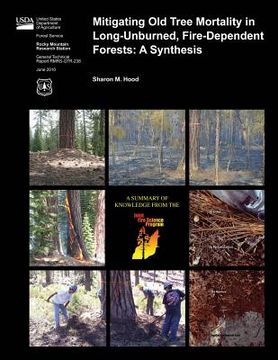Share
Mitigating Old Tree Mortality in Long-Unburned, Fire-Dependent Forests: A Synthesis
Sharon M. Hood
(Author)
·
Createspace Independent Publishing Platform
· Paperback
Mitigating Old Tree Mortality in Long-Unburned, Fire-Dependent Forests: A Synthesis - Agriculture, U. S. Department of ; Service, Forest ; Hood, Sharon M.
Choose the list to add your product or create one New List
✓ Product added successfully to the Wishlist.
Go to My Wishlists
Origin: U.S.A.
(Import costs included in the price)
It will be shipped from our warehouse between
Friday, August 09 and
Wednesday, August 21.
You will receive it anywhere in United Kingdom between 1 and 3 business days after shipment.
Synopsis "Mitigating Old Tree Mortality in Long-Unburned, Fire-Dependent Forests: A Synthesis"
Historically, many forested ecosystems in the United States burned frequently, both from lightning ignited fires and from Native American burning. Frequent fire maintained low fuel loadings and shaped forests composed of tree species adapted to survive low-intensity frequent fire. In the early 1900s, the United States government initiated a program to suppress all fires, both natural and anthropogenic. Many unintended consequences have resulted from over a century of fire suppression, such as increased tree densities and fuel, increased stress on older trees from competition, and greater risk of bark beetle attacks. These consequences are especially apparent in forests that historically burned frequently and have thus missed many fire cycles. Maintaining old trees and perpetuating large-diameter trees is an increasing concern. Stands of old trees that were historically common across vast landscapes in the United States are now relatively rare on the landscape because of harvesting (Noss and others 1995). Though logging is no longer the principal threat to most old-growth forests, they now face other risks (Vosick and others 2007). Prescribed fire has become a major tool for restoring fire-dependent ecosystem health and sustainability throughout the United States and use will likely increase in the future. However, increased mortality of large-diameter and old trees following fire has been reported in many areas around the country, and there is increased concern about maintaining these on the landscape (Kolb and others 2007; Varner and others 2005). As early as 1960, Ferguson and others (1960) reported high longleaf pine mortality after a low-intensity prescribed burn consumed the majority of heavy duff accumulations around the base of the trees. Mortality of pre-settlement ponderosa pines in prescribed burn areas in Grand Canyon National Park was higher than in control plots (Kaufmann and Covington 2001). After beginning a forest restoration program that reintroduced fire by prescribed burning at Crater Lake National Park, excessive post-fire mortality of larger ponderosa pine was observed in the burn areas, and early season burns had an even higher mortality than late season burns (Swezy and Agee 1991). Both Swezy and Agee (1991) and McHugh and Kolb (2003) reported a U-shaped mortality distribution for ponderosa pine following wildfires, with smaller- and larger-diameter trees having higher mortality than mid-diameter trees. Forest managers around the country have expressed concerns about large-diameter and old tree mortality when prescribed burning in long-unburned forests. The synthesis herein suggests recommendations for maintaining and perpetuating old trees in fire-dependent ecosystems. It expands on efforts funded by the Joint Fire Science Program (JFSP) to define the issues surrounding burning in fire excluded forests of the United States that are adapted to survive frequent fire. When the JFSP initially funded this synthesis, two JFSP projects were examining the effect of raking on reducing old ponderosa and Jeffrey pine (subsequently published in Fowler and others 2010; Hood and others 2007a). Another JFSP project examined the effect of prescribed burning under different duff moisture conditions on long-unburned old longleaf pine mortality (Varner and others 2007). Two other syntheses were also recently published on this subject: Perpetuating old ponderosa pine (Kolb and others 2007) and The conservation and restoration of old growth in frequent-fire forests of the American West (Egan 2007). The scope of the synthesis herein focuses only on limiting over story tree mortality in species adapted to survive frequent fire; therefore, the implications of fire suppression and fuel treatments on other ecosystem components are not discussed.

